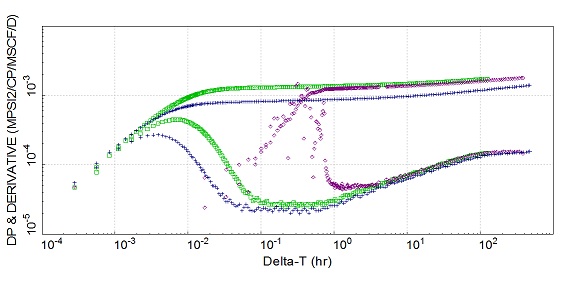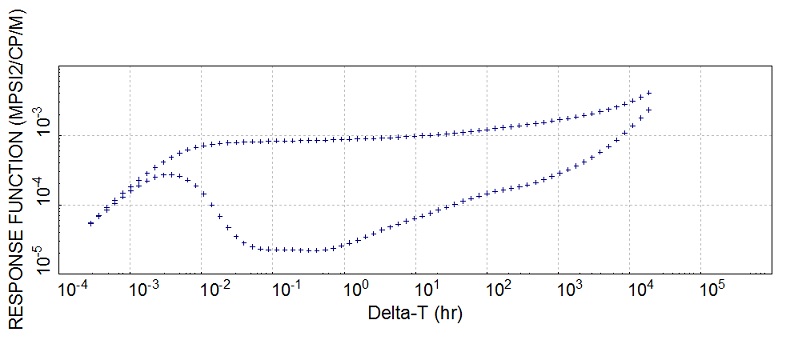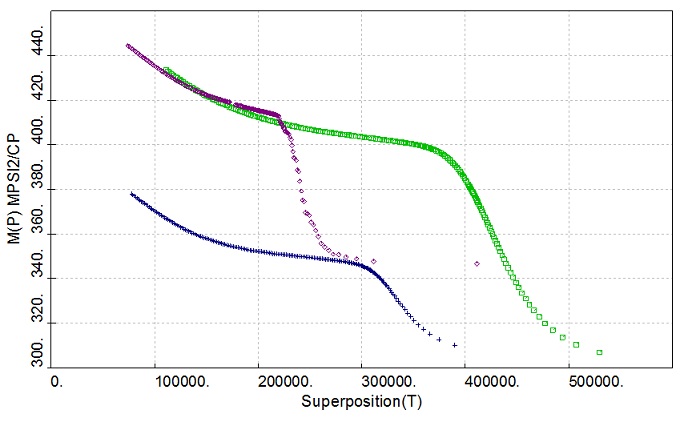Long Horizontal Well Analysis
The basic horizontal well model is characterized by the presence of an early vertical radial flow, an intermediate (linear) flow and eventually the horizontal radial flow regimes.
The figure below presents the pressure and derivative data of some PBU tests on a rate normalized log-log plot for a horizontal well in a sandstone reservoir.
One of the PBU tests (purple points) was performed with the surface production choke. This slow shut-in masks the pressure transient behaviour at early times before 1 hour. Without the other derivatives, the false stabilization from 1 to 3 hours could be misinterpreted as vertical radial flow regime, over-estimating the productive length and significantly under-estimating the vertical permeability value.
The derivative responses show a similar behaviour:
• At early times, a unit-slope straight line and a hump up to 0.1 hr representing wellbore storage and skin,
• A first stabilization, from 0.1 to 1 hr, probably representing vertical radial flow regime,
• An increase in derivative, tending at late times towards a late stabilization at about 100 hrs which could represent horizontal radial flow regime. This is the most important radial flow regime since it gives the horizontal permeability and helps to calculate all other parameters (vertical permeability, productive length, reservoir pressure).
The horizontal well was left shut-in for longer to clearly observe this late time stabilization. But what if the analysis is based on a wrong stabilization ? What if this is a “false” stabilization ? Not only will the PBU extension be a waste of time and money but all the calculated parameters (permeability, productive length, reservoir pressure) will be wrong. What if there was a way to learn about this stabilization without a long PBU duration ?
The figure below presents the deconvolved response obtained from the 2 longest PBU tests with a refined initial pressure. A rigorous process was followed to ensure the validity of deconvolution.
As shown in the figure above, the deconvolved response is defined over a time interval of 19,000 hrs (2 years), i.e. the duration of the entire test sequence since start-up.
The figure below shows the conventional and deconvolved derivative data.
Deconvolution (in red) confirms the earlier observations at early and middle times: a first derivative stabilization around 0.1 hr indicative of vertical radial flow regime and a later increase of derivative. A classical half-unit slope straight line indicative of linear flow is not presented, which could be explained by wellbore hydraulics (the well behaves like a finite conductivity horizontal well caused for example by a non-uniform skin or a small wellbore radius) or by a possible heterogeneity in the reservoir (multi-layer system).
At late times, from 100 hrs onwards, the conventional and Deconvolution responses have different behaviour. Whereas the build-up derivative seems to stabilize at late times, the deconvolved derivative continues to increase and follows a trend approaching a slope of one at late times.
A significant amount of information can be derived from this observation. First, the final stabilization on the build-up derivative which was initially assumed to be the horizontal radial flow regime is believed to be a distortion caused by the derivative calculation algorithm. This is a “false” derivative stabilization at late times. This means that some reservoir boundaries are so close to the well that the horizontal radial flow regime never develops. Thus the horizontal permeability kH and the total skin values are not fixed. However, as the intermediate flow regime gives kHL2 and deconvolution provides a response over a long time interval, the range of possible kH values can be reduced.
Then, the unit slope straight line in the deconvolved response shows that pseudo-steady state has been reached. While no clear boundaries were visible in the conventional derivative, we know from deconvolution that the reservoir is closed. This could also be supported by the superposition plot below, which shows a downward shift of the different pressure build-up data.
Deconvolution becomes the driving tool for analysis and helps to improve the understanding of the pressure transient response.





